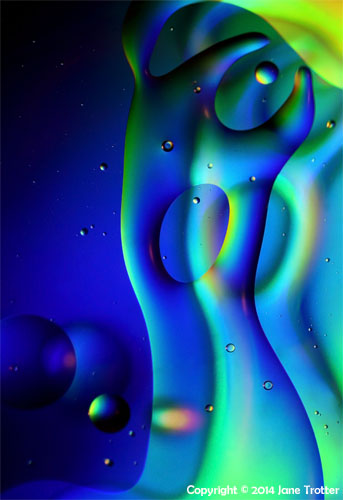Enjoy the beautiful and vibrant photography of Jane Trotter, whose work focuses on transforming everyday objects into fantastical abstract images. To see more of this talented photographer’s work, please visit her website.

“First Contact” Photograph, Durst Lambda Print, size varies
I have always been drawn to abstract photography. As a viewer, I love imagery which embodies the mysterious and stimulates my imagination. As a photographer, I love the process of transformation and the challenge of creating something new and different out of what exists already.

“Colour Contours” Photograph, Durst Lambda Print, size varies
I haven’t had to travel far to find the inspiration for my images. In fact, I haven’t had to travel at all. My home is my muse. All of my photographs use everyday domestic items found around the house.

“Colour Cathedral” Photograph, Durst Lambda Print, size varies
When I first began making photographs, my photo editing skills were very rudimentary. This meant my abstract exploration had to be done “in camera” rather than employing post production techniques to construct the final image.

“Golden Spirals” Photograph, Durst Lambda Print, size varies
Having to rely on my own imagination and creativity was invigorating and I embraced the challenge. Through this process I came to realise how highly I value the truthfulness and authenticity of a photographic image. I don’t want to manufacture an image in the computer. Paradoxically, I want my “unreal” abstracts to be as “real” and authentic as possible. While I do undertake basic enhancements to my images, essentially what you see in the final presentation is what I saw through the lens.

“Ghost in the Machine” Photograph, Durst Lambda Print, size varies
Making abstracts is a joy and an adventure. I will spend hours and days playing with objects and exploring their inner possibilities. It’s almost as if I am unlocking a puzzle. The more time I spend with my subject, the more it will slowly reveal itself to me and I can begin to uncover its mysteries and beauty.

“Tulip” Photograph, Durst Lambda Print, size varies
Through the course of my experimentation, I decided to try presenting my abstracts in a triptych format. I have been completely captivated by triptychs ever since. The three panels afford me even greater flexibility and freedom, the opportunity to present a more expansive vision and the chance to broaden and test compositional boundaries.

“Over the Shoulder” Photograph, Durst Lambda Print, size varies
Simplicity and a solid compositional foundation are vital for the success of an abstract image. I like to use bold shapes and patterns and strong, simple design elements to provide structural cohesion in my photography.

“Prismatic” Photograph, Durst Lambda Print, size varies
Employing a vibrant colour palette, I then utilise these colours to highlight and dramatise shape and form.

“Ingrained” Photograph, Durst Lambda Print, size varies
Whereas I am self-taught as a photographer, my formal training is in piano performance. I have taught the piano for over 20 years and have composed five books of children’s piano music. With my experience in both disciplines I have come to believe there is much creative overlay. A piece of music and a photograph make us feel something. They speak to us on an emotional, instinctive and subconscious level.

“Astral Plane” Photograph, Durst Lambda Print, size varies
As a musician, my role is to take the notes on the page and transform them into sound with character and meaning, imbuing them with my own unique voice. In a similar way, my role as an abstract photographer is to take an object in its basic state and transform it into something beyond itself, imbuing the photograph with my own unique vision.
Jane Trotter invites you to follow her on Facebook, Twitter and LinkedIn.


Your work is magnificent and awe inspiring. You take abstract photography to a new level. I’m also an artist who is deeply connected to music. Please find me on FB if you’re on it.
Hi Elaine
Many thanks for your wonderful words of support. I greatly appreciate it.
Gosh Jane I didn’t realise you’ve composed books of music as well. Much admiration. 🙂
Thanks very much Lisa. I composed these about 10 years ago.